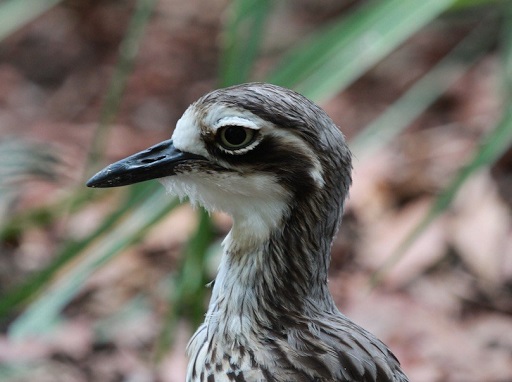Bush stone curlew
The bush stone curlew has significantly diminished in number, if you are lucky enough to share your surrounds with this bird its haunting call is unmistakable.
Article and images by Dr Julie O'Connor, Senior Conservation Partnerships Officer, Sunshine Coast Council
…they rend the air,
like cries of despair,
the screams of the wild Curlew
Henry Kendall 1862 The Curlew Song
The first time I heard the call of a bush stone curlew I was moved beyond measure by its wonderful ethereal call. The bush stone curlew has significantly diminished in number across its range, but if you are lucky enough to share your surrounds with this iconic Australian bird, its haunting ‘wee-ier, wee-ieer, whee-ieeer, whee-ieer-loo’ call is unmistakable. Listen to the Qld Museum Discovery Centre sound file.
The bird’s capacity to 'touch the soul' seems universal in Australia. It features strongly in many Aboriginal cultural stories in areas as widely separated as the Tiwi Islands and the Tanami Desert.
The curlew also captured the imaginations of European settlers in Australia. A contributor to the Daily Mail 15 January 1921 noted that “The most familiar nocturnes were those of the dingo, the mopoke and the stone curlew. The dingo’s howl was always a lonely sound, the call of the mopoke was sadly sweet, and far-reaching, but nothing played on the emotions so much as the cry of the stone curlew. At one moment it was clear and sharp, then it was drawn out into a long, low wail, and again wild piercing screams echoed through the timber, such as might be wrung from a terrified woman”.
A writer in the Lithgow Mercury 30 August 1940 wrote of the curlew that “In the neighbourhood of settlers’ homes nightly soon after twilight and often later, its piercing-whistling peals producing a sensation of loneliness and a feeling of “the creeps” in the listener”.
The bush stone curlew also occupies a unique space in Australian poetry. Famous poets of the 19th century frequently used it to evoke images of a lonely harsh bush, such as Henry Lawson’s 1887 reference to “the dismal curlew’s scream” in Golden Gully. Similarly, Henry Kendall’s describes the “unearthly screams”, “shrieks of the wild curlew” and “the wails of the sad curlew” in his 1862 poem The Curlew Song.
The mostly nocturnal bush stone curlew (Burhinis grallarius) specialises in hunting small prey including; lizards, frogs, invertebrates, snakes, small mammals as well as seeds.
Usual breeding time is in spring and early summer, but they may breed at any time if conditions are suitable. The unusual courtship dance of the bush stone curlews has been likened to soldiers marking time as they stamp their feet up and down.
Like a number of other ground breeding birds, the adult curlew will often feign injury to attract intruders away from newly hatched chicks. Chicks are precocial, being able to walk within a few hours of hatching and are fully grown within around 7 weeks.
Although they are quite good fliers, they will freeze when disturbed in an attempt to blend in with their surroundings and will often choose running before flying. Freezing in place generally serves them well to avoid native predators such as raptors but may have left them vulnerable to some introduced predators that rely more on scent than eyesight. In fact it is thought that predation by feral cats and foxes may be a major contributor to its decline in the southern states of Australia, in addition to habitat clearance and modification. As early as 1940, the writer of the article in the Lithgow Mercury referred to above warned that the comparative rarity of the curlew was attributed to expanding settlement and the “ravages of the fox”. A South Australian study found that on Kangaroo Island, where foxes are absent and habitat clearing is now minimal, the bush stone curlew is doing very well compared to mainland southern states.
Further reading:
- Gates, Jody A. 2001. An ecological study of bush stone-curlews Burhinus grallarius on Kangaroo Island, South Australia, Masters of Science, Adelaide University.

